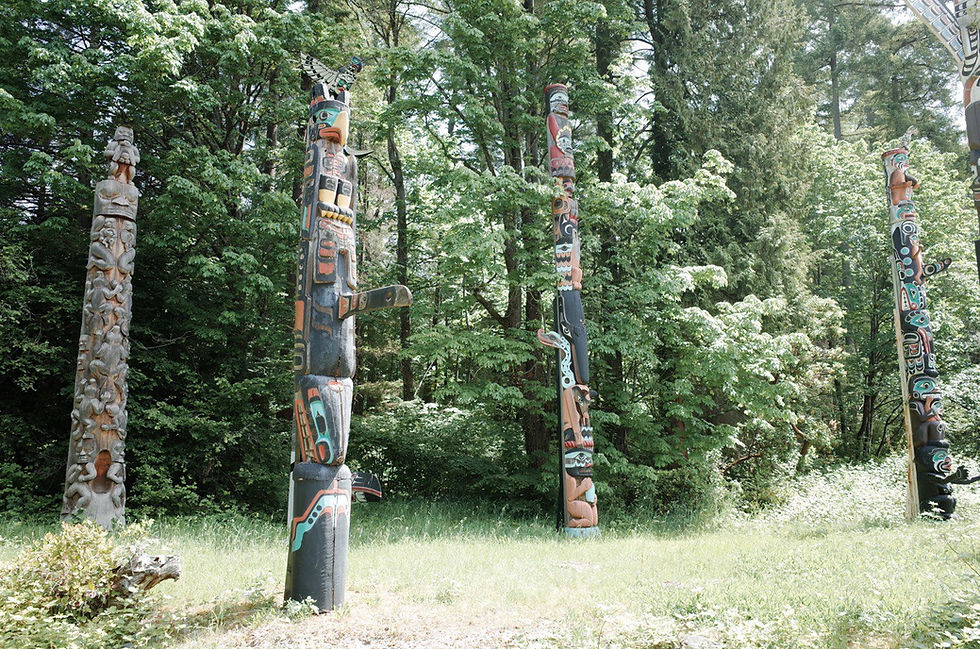It was incredibly nice weather during the Memorial Day weekend in Vancouver. The air was still a bit chilly, but under the spring sun, our bodies became warm and soft. After a delicious breakfast in a Japanese coffee shop, we headed towards the famous Stanley Park.
Stanley Park covers an area of 405 hectares (1,001 acres) and is surrounded by water on three sides. It was designated as a park in 1888 and named after Lord Stanley, the governor-general of Canada at the time. The park features a variety of natural and cultural attractions, such as forests, beaches, gardens, monuments, totem poles, and the Vancouver Aquarium.

Embarking on our journey, we traversed the renowned seawall, a mesmerizing 10-kilometer pathway that encircles the park, revealing vistas that effortlessly merge land, sea, and sky. The rhythmic lapping of ocean waves accompanied our exploration, as coastal breezes carried the melodies of seabirds soaring above. Visitors can observe various seabirds, such as gulls, cormorants, and ducks, flying over the water or resting on the rocks. Sometimes, a raven may join them, showing off its intelligence and curiosity. Another majestic bird that can be seen near the seawall is the great grey heron, standing tall and still in the shallow water, waiting for its prey. Other sea animals that live near the seawall include whales, sea otters, and harbour seals, attracted by the clean water and the herring that spawn in False Creek.

Venturing deeper into the heart of the park, we took the small paths to explore the verdant forests that embraced us with open arms. Mighty cedars, hemlocks, and firs stood tall, their outstretched branches weaving an emerald canopy overhead. As we meandered along the labyrinthine trails, nature revealed her hidden treasures: delicate ferns unfurling in dappled sunlight, vibrant wildflowers dotting the understory, and moss-clad logs whispering tales of ancient wisdom. My chest filled with the fresh, serene, and almost sweet fragrance of the deep-wooded soil. The green smell was a mix of early spring blooms, growing ferns, and fallen pines from past years.

One of the most remarkable aspects of Stanley Park is its wildlife. The park provides a habitat for over 230 species of birds, 50 species of mammals, 20 species of amphibians and reptiles, and countless insects and other invertebrates. We didn't bring binoculars for this short weekend trip, but we completely immersed ourselves in nature, listening intently, deeply inhaling the smells, and observing everything with wide-open eyes. Besides the coastal environment, the high canopies, and some open meadow areas at the edge of the woods, there is also a freshwater lake hidden in the park.

A tranquil oasis awaited us at Beaver Lake, a mirror-like expanse nestled serenely amidst the surrounding foliage. The gentle ripples of the lake mirrored the tranquility that washed over us, inviting us to witness a world teeming with life. It's a natural wetland area fed by small streams and rainfall.

It's indeed a bird's heaven. Wood duck moms swam with a line of little fuzzy balls behind them. Red-winged blackbirds sang amazing tunes that we never had the luck to hear in our own backyard. Using the Merlin App, we identified Song Sparrow, American Robin, Cedar Waxwing, Townsend's Warbler, and Western Tanager all at once, chorusing in the high cedar canopy tops. Thousands of water lilies, with pink and white flowers, floated on the giant lake. The lily pads reflected the gentle Spring sun like they were collecting little twinkling jewels. Around the lake in the bog areas, there were bright yellow and purple irises. There were educational signs about the wildlife and ecosystems around the lake. Birders, local families, and tourists all quietly enjoyed the amazing harmony of nature. Without seeing all the people around, you would not believe this beautiful place is just nestled in a metropolitan city.


Stanley Park, at its essence, symbolizes the remarkable potential of urban parks to serve as bridges between humanity and the natural world. It beckons city dwellers to step away from the frenetic pace of urban life, immersing themselves in the restorative embrace of nature. This sanctuary offers an invaluable opportunity to cultivate environmental awareness and reverence for the interconnectedness of all living beings. It's a testament to the fact that vibrant biodiversity and urban living need not exist as adversaries, but rather as harmonious partners in a delicate dance.

Here, people from all walks of life can seek solace, engage in recreational pursuits, and discover a deep connection to the wild essence that weaves through the heart of the city. With each visit, Stanley Park invites us to rediscover our place within the broader tapestry of life, fostering a harmonious coexistence that nourishes both the human spirit and the thriving ecosystems that call this sanctuary home.

Commentaires